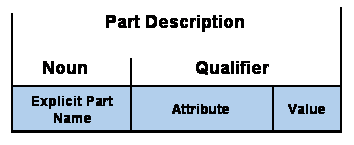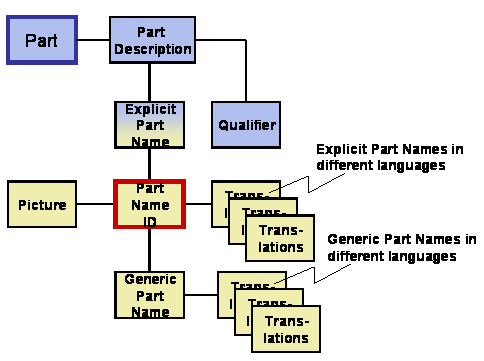Part Names – Part Description – Languages etc.
Part Name is a normal attribute to the Part. This may seem very simple but just wait and see.
In an Extended and Global Enterprise you will definitely need several languages. Hopefully, you can do with just one language inside the PDM applications. I would recommend English. Not because I like Americans or people from Great Britain so much, but because English has actually taken the role that once was intended for Esperanto. It is in fact The World Language that is known by everybody who have some education.
There is also another reason. If you want to attempt automatic translation there are lots of translators and dictionaries available based on English. They are fewer in any other language. So, let us assume that English will be the basic language.
 However, you will probably need different types of Part Name:
However, you will probably need different types of Part Name:
- A Generic Part Name that may be common to several more explicit Part Names. Example: Bracket.
- An Explicit Part Name. Example: Spring Bracket, Engine Bracket or Guide Bracket.
- An Explicit Part Name in several languages
- Generic Part Name in several languages
An Explicit Part Name is always a noun that is used in a Part Description. A Part Description is assigned to each Part in the Part Master Database. But, you may need a shorter version of the Part Description to be used in the BoM and in other contexts where you may be short of space. Hence, The Part Description should exist in a long and a short version per Part Identity in the Part Master Database.
A Part Description consists of a an Explicit Part Name and a Qualifier that consist of two attributes: ”property” and ”value”.
If the Naming Convention is practiced strictly, it will be possible to use the Part Description and its components in a Part Retrieval Application that can to a large extent support reuse of current and already developed Parts.
Where or how the Part is used in the Product Structure is not a Part related information. Whether the Part is located ”front” or ”lower” or ”left” is related to the Product Structure and should be part of the Product Structure Record (PSR).
Then there is a need to able to translate the Part Name Noun to other languages:
- The Part with it’s Explicit Part Name will be necessary in the local language on the shop floor documentation where people may not understand English well enough. Several languages may be necessary.
- The Generic and/or Explicit Part Name will be needed in the Parts Catalogues and these will be available at the dealers at the different markets. Several languages are necessary.
- Service and Workshop Manuals are also need in several languages. Mechanized translations can save a lot of money. A database with Explicit Part Names in all languages is needed for such translations and will save money. The translation of Part Names to several languages is difficult and costly due to the very specific terminology that exist for the Products and the area of work it is used in. The terminology existing for any chosen Product is not part of the knowledge learnt at the university. Such knowledge is learnt through experience, long experience – per language.
 A way to short-cut this obstacle is to give each Explicit Part Name a Part Name ID. Attached to this Part Name ID you relate one or several pictures (pictogram) that describes what is intended with the Part Name. This ”graphical Part Name” can then easily be used by people in the business at the various locations/dealers/plants around the world to tell what the proper Part Name should be in their language.
A way to short-cut this obstacle is to give each Explicit Part Name a Part Name ID. Attached to this Part Name ID you relate one or several pictures (pictogram) that describes what is intended with the Part Name. This ”graphical Part Name” can then easily be used by people in the business at the various locations/dealers/plants around the world to tell what the proper Part Name should be in their language.
It may also be necessary or convenient to handle Homonyms: Part Names that may translate to two or more Part Names in other languages, i.e actually have two or more meanings. Example: washer could mean a the round thing you may use as a distance under a screw or the windshield washer. So, be specific where you can.
It is recommended to stick to have all Part Names Nouns in single form with no article.
It is still a lot of work to set up a Part Name Dictionary Database but it is definitely worth it.
Once the database is there it will need a continuous maintenance since new parts will emerge and new languages will be necessary for new Markets or new Plants. And there will always be opinions about translations of Part Names since, apart from the terminologies, there are lots of dialects or versions of English, Spanish, Portuguese and French etc. in existence.
The development of the Part Name Dictionary and the rules for how to use this in the PDM applications is, of course, part of the development and maintenance of the PDM applications.
